How early in the songwriting process do you think about the formal design of your song? Do you ever think about verse-chorus design options of your song as soon as you create a good songwriting idea?
As you’ll hopefully know, getting good songwriting ideas is not the same thing as being able to write a complete song. A good idea is usually just a starting point. So what do you do if all you come up with are good ideas, but never a complete song?
 “Chord Progression Formulas” shows you a system for creating your own progressions in seconds using some basic formulas, in both major or minor keys. It’s available at the Online Store.
“Chord Progression Formulas” shows you a system for creating your own progressions in seconds using some basic formulas, in both major or minor keys. It’s available at the Online Store.
Here’s an option: Try designing the song before you know what else you’re going to write. Here’s what I mean.
Let’s say that you’ve got a good chorus hook, but don’t know what else to do. You can make good headway by coming up with a design for the rest of the song by doing this:
- Create a formal design for your song. This can change as you work, but as a starting point, make a quick decision about what you want the basic structure of the song to be. You might, for example, choose: Verse – Chorus – Verse – Chorus – Bridge – Chorus.
- Write down the basic range of your chorus hook. In other words, make note of your lowest and highest notes and write that down. (C4 – C5, for example. ‘C4’ stands for ‘middle C’, and C5 is the octave above it.)
- Now create a basic range for your verse. This should be lower than your chorus, as that’s a norm in most pop songwriting. So you might choose G3 – E4 as a preliminary range. That’s the G below middle C up to the E above middle C.
- Use your chorus progression for your verse. Not every song does this, but there’s no reason to feel you have to come up with something totally unique for your verse progression.
- Try to create a verse melody that stays in this lower range. You might borrow some rhythmic or melodic ideas from your chorus to create your verse. Think about good songs that you enjoy, and compare the verse and chorus. What similarities do you notice? In Adele’s “Hello”, each phrase of the chorus is in an inverted-U shape, and you’ll find a similar kind of shape used for each phrase of the verse. But also, there is no rule that says that a verse and chorus must have any similarities to each other at all.
Now that you have a verse and chorus, you can begin to give thought to how a bridge might be the right finishing touch. If your song is high energy and powerful, a calmer, more introspective bridge might be a good contrast.
But for many songs, songwriters use the bridge to provide the song’s ultimate high point. You’ll need to create a new melody here, one that moves higher and builds energy.
And just to reiterate, there’s no need for the verse, chorus, or any other section, to be closely related. Many groups and songwriting partnerships will write songs by having several members contribute otherwise unrelated ideas.
So it may sound like I’m stating the obvious here: if you’ve got a chorus fragment, you need to get busy and write the rest of the song! But in fact, what I’m saying is that for so many novice songwriters, the “I can’t finish anything” syndrome comes from not having a specific formal design in mind.
Considering the formal design of your song can be a vital first step to making the writing process less random and more satisfying in the long run.
 Written by Gary Ewer. Follow Gary on Twitter
Written by Gary Ewer. Follow Gary on Twitter
 Get the eBook Bundle package that’s being used by thousands of songwriters to polish their songwriting craft. “The Essential Secrets of Songwriting” 10-eBook Bundle covers every aspect of good songwriting, and comes with a free copy of “Creative Chord Progressions”
Get the eBook Bundle package that’s being used by thousands of songwriters to polish their songwriting craft. “The Essential Secrets of Songwriting” 10-eBook Bundle covers every aspect of good songwriting, and comes with a free copy of “Creative Chord Progressions”










